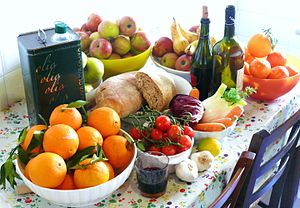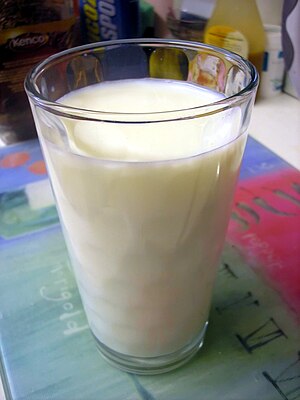Weight management/ja: Difference between revisions
No edit summary Tags: Mobile edit Mobile web edit |
|||
| (4 intermediate revisions by the same user not shown) | |||
| Line 173: | Line 173: | ||
==== 食物繊維の摂取量を増やす ==== | ==== 食物繊維の摂取量を増やす ==== | ||
上述したように、果物と野菜は食物繊維の2つの供給源である。[[Dietary fiber/ja|食物繊維]]は、満腹感を誘導し、[[macronutrients/ja|大栄養素]]の吸収を低下させ、腸内ホルモンの分泌を促進することで、体重管理を助けることが示唆されている。食物繊維は難消化性炭水化物と[[lignin/ja|リグニン]]からなり、植物の構造成分である。 | 上述したように、果物と野菜は食物繊維の2つの供給源である。[[Dietary fiber/ja|食物繊維]]は、満腹感を誘導し、[[macronutrients/ja|大栄養素]]の吸収を低下させ、腸内ホルモンの分泌を促進することで、体重管理を助けることが示唆されている。食物繊維は難消化性炭水化物と[[lignin/ja|リグニン]]からなり、植物の構造成分である。 | ||
[[File:Foods.jpg|alt=果物や野菜には天然の食物繊維が含まれており、満腹感の向上につながる。]] | [[File:Foods.jpg|alt=果物や野菜には天然の食物繊維が含まれており、満腹感の向上につながる。|thumb|果物や野菜には食物繊維が含まれており、満腹感を高めて減量に役立つことが分かっている。]] | ||
食物繊維を多く含む食品は体積が大きく、水分を多く含むため、食物繊維は食事から摂取可能なカロリーや栄養素を置き換える。粘性のある食物繊維を摂取すると胃排出が遅延するため、満腹感が長く続く可能性がある。満腹感はまた、[[saliva/ja|唾液]]と[[gastric juice/ja|胃液]]の分泌を促進し、胃の膨張をもたらすことによって食物摂取を制限する咀嚼の増加によっても誘発される。さらに、食物繊維摂取中はホルモン分泌に影響を及ぼす。インスリン反応が低下し、小腸の[[cholecystokinin/ja|コレシストキニン]](CCK)が増加する。インスリンは[[blood glucose/ja|血糖値]]を調節し、CCKは胃排出、[[pancreatic/ja|膵臓]]分泌、[[gall bladder/ja|胆嚢]]収縮を調節する。CCKと食物繊維含有量の異なる食品を摂取した後の満腹感には直接的な相関関係がある。 | 食物繊維を多く含む食品は体積が大きく、水分を多く含むため、食物繊維は食事から摂取可能なカロリーや栄養素を置き換える。粘性のある食物繊維を摂取すると胃排出が遅延するため、満腹感が長く続く可能性がある。満腹感はまた、[[saliva/ja|唾液]]と[[gastric juice/ja|胃液]]の分泌を促進し、胃の膨張をもたらすことによって食物摂取を制限する咀嚼の増加によっても誘発される。さらに、食物繊維摂取中はホルモン分泌に影響を及ぼす。インスリン反応が低下し、小腸の[[cholecystokinin/ja|コレシストキニン]](CCK)が増加する。インスリンは[[blood glucose/ja|血糖値]]を調節し、CCKは胃排出、[[pancreatic/ja|膵臓]]分泌、[[gall bladder/ja|胆嚢]]収縮を調節する。CCKと食物繊維含有量の異なる食品を摂取した後の満腹感には直接的な相関関係がある。 | ||
一般に、朝食時の食物繊維の大量摂取は、昼食時の食物摂取量の減少と関連している。食物繊維には、消費者が一日を通して食事量を減らすのを助けるという利点もあるかもしれないが、この可能性を検討した研究の結果は相反するものであった。 | |||
==== レジスタントスターチの摂取量を増やす==== | |||
= | レジスタントスターチは、[[small intestine/ja|小腸]]で[[amylase/ja|アミラーゼ]]による消化を受けにくい、難消化性の[[Fermentation (food)/ja|発酵]]繊維の一種である。[[large intestine/ja|大腸]]では[[microflora/ja|微生物叢]]によって[[short-chain fatty acid/ja|短鎖脂肪酸]]に分解される。調理して冷やしたジャガイモ、青バナナ、豆類、豆類によく含まれる。短鎖脂肪酸は脂肪をさらに酸化させ、エネルギー消費量を増加させる。レジスタントスターチは、食物摂取のエネルギー密度を薄め、非発酵性食物繊維と同様の増量効果を維持し、腸内ホルモン[[peptide YY/ja|PYY]]と[[glucagon-like peptide-1/ja|GLP-1]]の発現を増加させる。腸内ホルモンの発現増加は、長期的なエネルギーバランスと[[intestines/ja|腸]]の全体的な健康状態の改善に寄与する脳のニューロン経路に影響を与える。 | ||
==== カフェイン摂取量の増加 ==== | |||
= | [[caffeine/ja|カフェイン]]およびブラック[[coffee/ja|コーヒー]]は、エネルギー消費の増加およびその後の体重減少と関連している。カフェインは[[methylxanthines/ja|メチルキサンチン]]と呼ばれる化合物の一群に属し、コーヒー、紅茶、ココア、チョコレート、一部のコーラ飲料に含まれている。カフェインは、エネルギー消費の重要な調節因子である[[sympathetic nervous system/ja|交感神経系]]の活動を亢進させることにより、体内で[[Thermic effect of food/ja|発熱効果]]を誘導する。 | ||
[[ | |||
==== 緑茶の摂取量を増やす | |||
[[File:Health benefits of green tea.png|thumb|緑茶には減量を助けるカテキンが含まれている。]] | |||
[[File:Health benefits of green tea.png|thumb| | カテキンは[[tea polyphenol/ja|ポリフェノール]]であり、緑茶エキスの主要成分である。[[green tea/ja|緑茶]]は、製剤中に存在する[[tea catechins/ja|カテキン]]により、血糖値の低下、[[hepatic/ja|肝]]および体脂肪蓄積の抑制、熱発生の刺激と関連している。さらに、脳内のカテキンは満腹感に大きな役割を果たしている。カフェイン含有量とは無関係に、緑茶はヒトのエネルギー消費と脂肪酸化を増加させることも示されている。 | ||
緑茶の摂取だけでは体重やBMIを有意に減らすことはできないかもしれないが、減量を目的とした他の戦略と組み合わせて摂取することは、減量と体重維持の両方に役立つ可能性がある。 | |||
== こちらも参照 == | == こちらも参照 == | ||
Latest revision as of 15:37, 10 March 2024
| aシリーズの一部である。 |
| 体重 |
|---|

体重管理とは、健康的な体重を達成・維持するための行動や技術、生理学的プロセスを指す。ほとんどの体重管理技術は、健康的な食事と毎日の身体活動を促進する長期的なライフスタイル戦略を包含している。さらに、体重管理には、長期にわたって体重を追跡し、個人によって異なる理想的な体重を特定する有意義な方法を開発することが含まれる。
体重管理戦略では、多くの場合、ゆっくりではあるが着実に体重を減らして健康的な体重を達成し、その後理想体重を維持することに焦点が当てられている。しかし、健康に対する体重にとらわれないアプローチもまた、健康上の好ましい結果をもたらすことが示されている。
肥満は、2型糖尿病、高血圧、心血管疾患など、多くの慢性疾患発症の危険因子であるため、体重管理の基礎科学と、健康的な体重を獲得・維持するための戦略を理解することは非常に重要である。
主な要因
人の体重には、食事、身体活動、遺伝、環境要因、医療支援、医薬品、病気など、多くの要因がある。これらの要因はそれぞれ異なる方法で、程度の差こそあれ体重に影響を及ぼすが、意識的な行動修正によって影響を及ぼすことができるため、医療専門家は食事と身体活動の重要性を最もよく強調する。健康的な体重を得るには、分量の調節、自己管理、毎日の食事の一貫性など、一般的なテクニックを認識することが必要である。健康的な体重に到達した後は、この安定した体重を維持するために、さらに身体活動や個人の環境や食事パターンのコントロールが必要となる。さらに、長期的な体重管理には、プライマリ・ケアの医学的監督と長期的なフォローアップという形での医療支援が有用であることが示されている。
以下は、ヒトにおける体重管理の主要な構成要素についてのレビューである。
エネルギーバランス
体重管理の背後にある科学は複雑であるが、体重管理を支配する重要な概念の1つはエネルギーバランスである。エネルギーバランスとは、ある人が消費したカロリー数と、同じ人が一定期間に消費した(消費した)カロリー数との差を表す言葉である。エネルギー収支方程式に関しては、3つのシナリオが考えられる:
- 摂取カロリー(食べ物、飲み物)= 消費カロリー(基礎代謝量、身体活動、食べ物の熱発生効果、急性疾患)
- 結果: 体重は変化しない
- 消費カロリー>消費カロリー
- 正のエネルギー収支としても知られる。
- 結果:体重は増加する: 体重が増加する
- 消費カロリー<消費カロリー
- 負のエネルギーバランスとしても知られている。
- 結果:体重が減少する: 体重が減少する
人が消費するカロリーは、食べ物や飲み物の摂取によるものである。人が消費するカロリーは、基礎代謝量と日々の身体活動から得られる。人体は、特に果物、野菜、肉類で構成された食事を摂ることで、一定の時間内に消費カロリーが消費カロリーを大幅に上回ったり、逆に消費カロリーが消費カロリーを大幅に上回ったりしないように、中立的なエネルギーバランスを保つことに長けている。このエネルギーバランスは、食欲を抑制または刺激するレプチン(抑制)、グレリン(刺激)、コレシストキニン(抑制)などのホルモンによって調節されている。

食事療法
個人が摂取する飲食物の量は、その人が摂取する飲食物の種類と同様に、体重管理に関与する可能性がある。例えば、ソーダやジュースのような甘味飲料の摂取は、エネルギー摂取量の増加につながるが、付随する食品摂取量の減少では中和されない。分量の増加もエネルギー摂取量の増加につながる。
身体活動

身体活動は、その人の職業活動に関連したもの、ウォーキングやサイクリングのような仕事に関連しない日常的なもの、あるいはレクリエーションやチームスポーツのような活動の形態もある。 具体的な活動の種類は、子ども、妊婦、高齢者などの集団に合わせることができる。自分のフィットネス・レベルに合わせた活動は、身体が適切に回復するのを促し、運動による怪我を予防する。
運動不足はエネルギー消費量の低下につながり、子どもから大人まで肥満率に影響を与える要因となっている。運動不足は心臓病のリスクも高めるため、運動不足は世界的な問題となっている。定期的な身体活動は、糖尿病、心臓病、脂質異常症(高コレステロール)などの非伝染性疾患のリスクを減らすことができる。
基礎代謝量
基礎代謝量(BMR)は、人の1日のエネルギー消費量の主な構成要素の1つである。安静時の人が一定時間内に消費するエネルギー量として定義される。この安静時のエネルギーは、血液を全身に送り出し、脳の機能を正常に保ち、毒素を分解し、その他の身体機能を確保するために使われる。専門的に言えば、BMRとは、起床直後、安静時、12~14時間の絶食後という特定の条件下で身体が消費するエネルギーのことである。BMRの代わりに安静時代謝量(RMR)という言葉が使われることもあるが、RMRは先に挙げた厳しい条件下でのみ測定されるものではなく、BMRよりも10%ほど多い。
BMRは人の除脂肪体重に正比例する。言い換えれば、除脂肪体重が多いほどBMRは高くなる。BMRは急性疾患によっても影響を受け、火傷、骨折、感染症、発熱などで増加する。BMRは、直接熱量測定や間接熱量測定で測定することができる。しかし、年齢、性別、身長、体重を考慮したいくつかの計算式を用いて、BMRをおおよそ推定することも可能である。BMRを計算するために使用される最も一般的で正確な方程式のいくつかは、元のハリス-ベネディクト方程式、改訂されたハリス-ベネディクト方程式、およびミフリンセントジョー方程式である。
オリジナルのハリス・ベネディクト方程式は以下の通りである:
- BMR(男性)(Kcal/日)=66.47+13.75(体重kg)+5.0(身長cm)-6.76(年齢歳)
- BMR(女性)(Kcal/日)=655.1+9.56(体重kg)+1.85(身長cm)-4.68(年齢歳)
改訂版ハリス・ベネディクト方程式は以下の通りである:
- BMR(男性)(Kcal/日)=88.36+13.40(体重kg)+4.8(身長cm)-5.68(年齢歳)
- BMR(女性)(Kcal/日)=447.59+9.25(体重kg)+3.10(身長cm)-4.33(年齢歳)
ミフリン・セントジョール方程式は以下の通りである:
- BMR(男性)(Kcal/日) = 9.99(体重kg) + 6.25(身長cm) - 4.92(年齢歳) + 5
- BMR(女性)(Kcal/日) =9.99(体重kg)+6.25(身長cm)-4.92(年齢歳)-161
ミフリン・セントジョール方程式は、直接および間接熱量測定によるBMRと比較して、BMRの最も正確な予測因子であることが判明している。
体格指数
体格指数(BMI)は、その人の全体的な質量を知るために使われる値で、身長と体重を使って計算される。個人が低体重、標準体重、過体重、または肥満であるかどうかを判断するために、体重だけよりも頻繁に使用される。身長(メートル対インチ)と体重(キログラム対ポンド)の単位に応じて、次の2つの式を使用してBMIを計算することができる:
あるいは
BMIは体重過多の評価によく使われるが、体脂肪率を完璧に表すものではない。例えば、筋肉量が平均より多ければ、BMIは正常より高くても体脂肪率は正常である。過剰な筋肉は体重を増加させるからである。BMIは人の体脂肪率を完全に表すものではないため、不健康な体重超過をよりよく評価するために、ウエスト周囲径のような他の測定値がしばしば用いられる。
以下の表は、BMIの異なる範囲が、しばしば低体重、標準体重、過体重、肥満に分類されることを示している:

| カテゴリ | BMI |
|---|---|
| アンダーウエイト | < 18.5 |
| 標準体重 | 18.5 – 24.9 |
| オーバーウエイト | 25.0 – 29.9 |
| 肥満 (クラス I) | 30.0 – 34.9 |
| 肥満 (クラス II) | 35.0 – 39.9 |
| 肥満 (クラス III) | ≥ 40.0 |
平均して、BMIが "肥満"のグループは、糖尿病、高血圧、脂質異常症(高コレステロール血症)、肝臓病、およびいくつかの癌のような病気を発症するリスクが高いかもしれない。「低体重」のBMIは、栄養失調やその他の健康問題を示している可能性がある。しかし、BMI 限界は、人々の集団を記述するのではなく、個人の健康を記述するために使用される場合、限界がある。
複雑な要因
食物の熱発生効果
食物の熱発生効果は、人の1日のエネルギー消費量のもう一つの構成要素であり、食事中の栄養素を消化、吸収、代謝するのに要するエネルギー量を指す。食品を処理する際に消費されるエネルギー量は個人によって異なるが、平均すると一定期間に消費されるカロリーの約10%に相当する。タンパク質と炭水化物の処理は、脂肪の処理よりも熱発生効果が高い。
医薬品
特定の医薬品は、体重減少または体重増加を引き起こす可能性がある。そのような副作用は医薬品ごとに記載されていることが多く、体重管理を試みる際には考慮すべきである。
メタアナリシスでは、フェンテルミンとトピラマート、プラムリンチド、ナルトレキソン、ブプロピオン、リラグルチドが体重減少を誘導することが示されている。セマグルチドは、血糖コントロールにも使用される別の抗肥満薬物である。
病気
体重増加に関連する病状には、甲状腺機能低下症、クッシング症候群、多嚢胞性卵巣症候群(PCOS)、およびうっ血性心不全がある。がん、胃腸疾患、精神疾患、感染症、内分泌疾患、神経疾患などの医薬品は、体重減少を引き起こすことがある。
一般的に体重増加を伴う
多嚢胞性卵巣症候群(PCOS)は、インスリン抵抗性とアンドロゲン亢進症を特徴とし、肥満と関連している一般的な疾患である。遺伝、ライフスタイル、環境の組み合わせが、PCOS患者にみられる体重増加や肥満の原因となるホルモンの変化に寄与しているようである。肥満とPCOSの間には双方向の関係があるようで、PCOSは肥満のリスクを高め、同様に肥満はPCOSのホルモンの違いや臨床症状を悪化させることがわかっている。 肥満は膵臓のβ細胞機能障害やインスリン抵抗性と関連している。糖尿病では、β島細胞の障害が血糖コントロールの欠如の原因となっている。肥満に関する体格指数が高い人は、ホルモン、炎症性マーカー、グリセロールのレベルが上昇し、インスリン抵抗性を助長する可能性がある。膵β島細胞の障害とインスリン抵抗性の複合作用により、糖尿病を発症する可能性が高くなる。
血糖値が糖尿病前段階の人では、減量は血糖コントロールの改善や2型糖尿病の発症リスクの減少など、多くの利点があることが実証された。
体重減少に関連する一般的な疾患
体重減少に関連する一般的な消化管障害は、セリアック病または慢性膵炎による吸収不良である。うつ病や神経性食欲不振症などの摂食障害も体重減少の原因となる。体重減少の感染性の原因としては、HIV/AIDSがある。
1型糖尿病は体重減少を引き起こすことが判明しているが、2型糖尿病は体重増加と関連している。体重減少の原因となる他の内分泌疾患には、甲状腺機能亢進症や慢性副腎不全がある。
意図的な減量
ダイエット
減量は部分的にカロリー摂取量に依存するため、特定の大栄養素を強調したもの(低脂肪、低炭水化物など)など、さまざまな種類のカロリー低減ダイエットが減量手段として同様に有効であることが示されている。とはいえ、食物繊維を多く含む低飽和脂肪食は、BMIで肥満と判定された人には有効である。さらに、低炭水化物食は、2型糖尿病の人の血糖コントロールにも効果がある。低炭水化物食はまた、体重減少、HDL、特定の個人のコレステロールを改善することができる。一般的な食事と比較すると、低炭水化物食、低脂肪食、中等度多量栄養素食はいずれも体重減少にプラスの影響を与える。しかし、体重の戻りはよくあることであり、ダイエットの結果は個人によって大きく異なる。各ダイエットの微妙な違いに注目するよりも、一つのダイエットを長期的に継続できるような形にすることが、減量には効果的である。
- DASH食
高血圧を止めるための食事療法 (DASH食)は、果物、野菜、全粒穀物、低脂肪乳製品の摂取を増やすことに重点を置いている。DASHは、上昇した血圧を管理し、非薬理学的に心血管疾患を予防するための介入を提供する。さらに、DASH食とナトリウム摂取量の減少を組み合わせることで、血圧はさらに低下するが、治療効果には必要ない。なぜなら、DASH食は幅広いナトリウム摂取レベルで有効であることが証明されているからである。DASHに関する最近のレビューでは、手頃な減量手段としての有効性が引き続き提唱されているが、望ましい結果を得るためには食事療法の遵守が重要であることが強調されている。

- 地中海式ダイエット
地中海式ダイエットでは、果物、野菜、全粒穀物、豆類を食べる一方で、バターをエクストラヴァージンオリーブオイルに置き換え、赤身肉、乳製品、菓子類、加工食品を制限する。地中海式ダイエットは、長期的な減量に効果的で、さらに心臓血管の健康にも良いことが示されている。例えば、地中海食はトリグリセリドと脂質のレベルを下げ、血圧を改善する。また、2型糖尿病と診断された人の血糖値を改善することもできる。
- ケトジェニックダイエット
ケトジェニックまたは "ケト"ダイエットは、脂肪とタンパク質の量を増やすとともに、炭水化物の摂取量を毎日50グラム未満にする。ケトジェニックダイエットや低炭水化物ダイエットの一つのタイプは、タンパク質と脂肪の量を制限しない "アトキンス "ダイエットである。しかし、1日のタンパク質と脂肪の総量に制限を設けるケトジェニック・ダイエットもある。
- 植物ベースダイエット
植物ベースダイエットは、主に豆類、穀類、果物、野菜の摂取を基本とし、肉、魚、時には乳製品や卵製品の摂取を控える。言い換えれば、食物繊維と不飽和脂肪の摂取を増やし、高カロリーの肉と飽和脂肪の摂取を減らす。この食事法は肉食と比較してBMIを低下させ、体組成に良い変化をもたらすことが示されている。
- 間欠的ファスティング
間欠的ファスティング(IF)には、摂取カロリーを減らすかゼロにする一貫した絶食ブロックが含まれる。間欠的絶食は、空腹時血糖値とインスリン抵抗性を改善し、同時にBMIを低下させることが示されている。
戦略

皿の大きさを変える
小さな皿を使うことで、ポーションサイズが小さくなる可能性を示唆する研究もある。
ポーションサイズの変更はエネルギー摂取量に影響を与える可能性がある。より大きなポーションサイズを提示された人は、高いレベルの満腹感を得られなかったと報告している。つまり、ポーションサイズが大きいと、空腹感や満腹感のシグナルが無視される可能性がある。ポーションサイズに焦点を当てた研究では、参加者は、12インチのサブマリンサンドイッチの大きなポーションサイズと比較して、6インチのサブマリンサンドイッチの小さなポーションサイズで31%少ないカロリーを消費した。ポーションサイズの増加は、肥満率の増加と同時に起こっている。大きなポーションサイズは、米国における現在の平均体重増加の要因の一つである可能性がある。72のランダム化比較試験のシステマティックレビューから得られた証拠によると、人々は一貫して、より小さいサイズの代替品とは対照的に、より大きなポーション、パッケージ、または食器サイズを提供された場合に、より多くの食品を食べることが示されている。
低カロリー食品を選ぶ
体重を減らしたい人には、カロリー不足、特に1日500~750kcalの減量を勧められるというのが、ガイドラインの大方の意見である。摂取カロリーを適度に減らせば、体重はゆっくりと減少し、長期的な体重管理には急激な減量よりも有益なことが多い。例えば、低脂肪の肉類は摂取カロリーとコレステロールの総量を減らす。
タンパク質の摂取量を増やす
高タンパク質食は、低脂肪食や高炭水化物食に比べて熱発生を増加させ、食欲を減退させ、特に急速な体重減少が観察されるダイエット開始後3~6ヵ月は体重減少につながる可能性がある。 しかし、これらの利点は、ダイエット開始後12~24ヶ月の緩徐な体重減少期には減少する可能性がある。
スープを多く食べる
固形食品と比較すると、スープの摂取はエネルギー摂取量を減少させ、満腹感を増加させることが研究で実証されている。食前にスープを摂取すると、食事中に消費されるカロリーが20%減少する。
乳製品をもっと食べる

乳製品を多く含む食事は、体脂肪を減少させるという研究結果がある。これは、多量の食事性カルシウムが、体内から排泄されるエネルギーと脂肪の量を増加させるためである。 他の研究では、乳製品からのカルシウム摂取は、サプリメントによるカルシウム摂取よりも大きな体重減少をもたらすことが指摘されている。これは、特に低カロリーの食事と組み合わせた場合、乳製品に含まれる生理活性成分によるものと考えられる。ほとんどの天然乳製品には脂肪分が含まれているため、これが体重増加を引き起こす可能性があるというのが一般的な理解である。しかし、乳製品にはホエイたんぱくや、たんぱく質とカルシウムの栄養素の特定の組み合わせといった成分が含まれており、満腹感に好影響を与え、エネルギー損失を増加させ、体重減少を補助する。
野菜をもっと食べる
果物や野菜は満腹感を高め、空腹シグナルを減少させることが示されている。これらの食品群はエネルギー密度が低いが、これは主に水分が多いためであり、一部はファイバーを含んでいるためである。エネルギー密度の低下は満腹感を高めることが示されている。水分は過剰なカロリーなしに満足感を与え、食物繊維は胃の排出を遅らせる。また、食物繊維が空腹感を減らし、総エネルギー摂取量も減らすという研究結果もある。
食物繊維の摂取量を増やす
上述したように、果物と野菜は食物繊維の2つの供給源である。食物繊維は、満腹感を誘導し、大栄養素の吸収を低下させ、腸内ホルモンの分泌を促進することで、体重管理を助けることが示唆されている。食物繊維は難消化性炭水化物とリグニンからなり、植物の構造成分である。

食物繊維を多く含む食品は体積が大きく、水分を多く含むため、食物繊維は食事から摂取可能なカロリーや栄養素を置き換える。粘性のある食物繊維を摂取すると胃排出が遅延するため、満腹感が長く続く可能性がある。満腹感はまた、唾液と胃液の分泌を促進し、胃の膨張をもたらすことによって食物摂取を制限する咀嚼の増加によっても誘発される。さらに、食物繊維摂取中はホルモン分泌に影響を及ぼす。インスリン反応が低下し、小腸のコレシストキニン(CCK)が増加する。インスリンは血糖値を調節し、CCKは胃排出、膵臓分泌、胆嚢収縮を調節する。CCKと食物繊維含有量の異なる食品を摂取した後の満腹感には直接的な相関関係がある。
一般に、朝食時の食物繊維の大量摂取は、昼食時の食物摂取量の減少と関連している。食物繊維には、消費者が一日を通して食事量を減らすのを助けるという利点もあるかもしれないが、この可能性を検討した研究の結果は相反するものであった。
レジスタントスターチの摂取量を増やす
レジスタントスターチは、小腸でアミラーゼによる消化を受けにくい、難消化性の発酵繊維の一種である。大腸では微生物叢によって短鎖脂肪酸に分解される。調理して冷やしたジャガイモ、青バナナ、豆類、豆類によく含まれる。短鎖脂肪酸は脂肪をさらに酸化させ、エネルギー消費量を増加させる。レジスタントスターチは、食物摂取のエネルギー密度を薄め、非発酵性食物繊維と同様の増量効果を維持し、腸内ホルモンPYYとGLP-1の発現を増加させる。腸内ホルモンの発現増加は、長期的なエネルギーバランスと腸の全体的な健康状態の改善に寄与する脳のニューロン経路に影響を与える。
カフェイン摂取量の増加
カフェインおよびブラックコーヒーは、エネルギー消費の増加およびその後の体重減少と関連している。カフェインはメチルキサンチンと呼ばれる化合物の一群に属し、コーヒー、紅茶、ココア、チョコレート、一部のコーラ飲料に含まれている。カフェインは、エネルギー消費の重要な調節因子である交感神経系の活動を亢進させることにより、体内で発熱効果を誘導する。
==== 緑茶の摂取量を増やす

カテキンはポリフェノールであり、緑茶エキスの主要成分である。緑茶は、製剤中に存在するカテキンにより、血糖値の低下、肝および体脂肪蓄積の抑制、熱発生の刺激と関連している。さらに、脳内のカテキンは満腹感に大きな役割を果たしている。カフェイン含有量とは無関係に、緑茶はヒトのエネルギー消費と脂肪酸化を増加させることも示されている。
緑茶の摂取だけでは体重やBMIを有意に減らすことはできないかもしれないが、減量を目的とした他の戦略と組み合わせて摂取することは、減量と体重維持の両方に役立つ可能性がある。
こちらも参照
さらに読む
- Brownell KD (2004). The Learn Program for Weight Management: lifestyle, exercise, attitudes, relationships, nutrition (10th ed.). Dallas, Tex.: American Health Pub. Co. ISBN 978-1-878513-41-0.
- Dalton S (1997). Overweight and weight management: the health professional's guide to understanding and practice. Gaithersburg, Md.: Aspen Publishers. ISBN 978-0-8342-0636-6.
- Laliberte M, Taylor V, McCabe RE (2009). The cognitive behavioral workbook for weight management: a step-by-step program. Oakland, Calif.: New Harbinger Publications. ISBN 978-1-57224-625-6.
- Fulda J (2008). Half-Assed: A Weight-Loss Memoir. Berkeley, CA: Seal Press. ISBN 978-1-58005-278-8.
- Mann T (7 April 2015). Secrets From the Eating Lab: The Science of Weight Loss, the Myth of Willpower, and Why You Should Never Diet Again. HarperCollins. ISBN 978-0-06-232926-4.